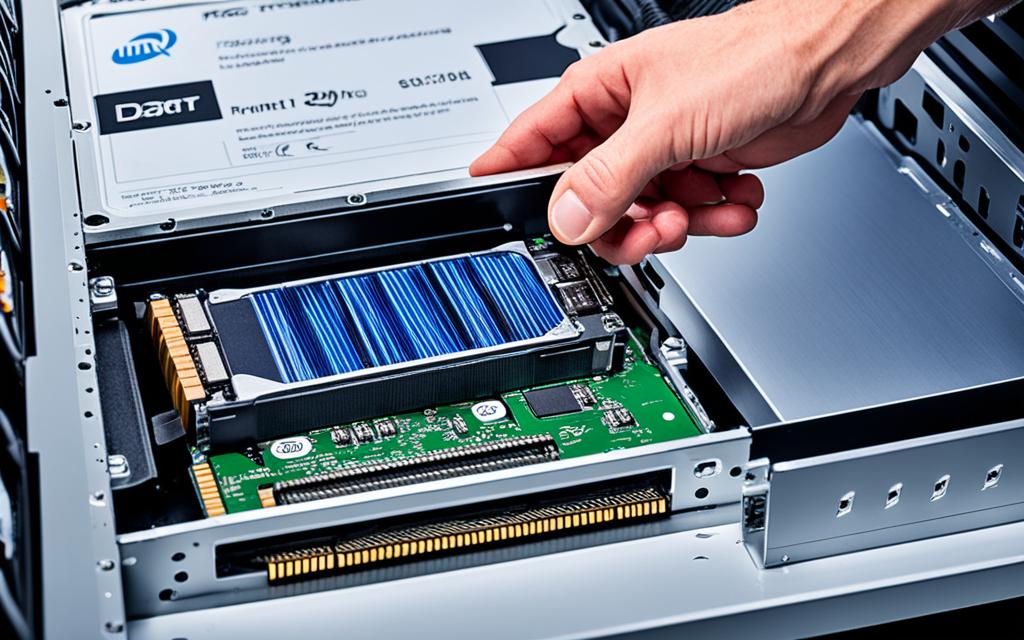Table of Contents
Putting Windows on a solid-state drive (SSD) can really speed up your PC. You’ll see it boot up faster and handle big tasks with ease. SSDs are faster and stronger than old hard drives, perfect for anyone wanting a boost1. If you’re new or seasoned in upgrading PCs, getting Windows onto an SSD can make a big difference. It’s not as hard as it seems. By learning this, you’re on your way to a smoother and more fun PC use2
Key Takeaways
- SSDs offer significantly faster boot times compared to HDDs.
- Installing Windows on an SSD can improve overall system responsiveness.
- Preparation is key: Backup your data and gather the necessary tools.
- Consider using OS migration software for a simplified transfer JPG.
- A fresh installation of Windows can be completed in approximately 30 to 45 minutes.
Understanding the Advantages of Installing Windows on an SSD
Putting Windows on a solid-state drive (SSD) brings many improvements to your computer. These benefits make your computer faster and more efficient.
Boosted Performance and Speed
SSDs shine with their amazing SSD speed benefits. They offer read and write speeds much higher than regular hard drives (HDDs). This can make your computer start up and open programs very quickly3. You’ll find your computer is quicker and more fun to use, even with lots of programs open.
Enhanced Reliability and Durability
An SSD is more reliable than an HDD because it has no moving parts. This design means there’s less chance of something breaking inside4. So, SSDs last longer, which is good news if you use your computer for important stuff.
Improved Power Efficiency for Laptops
SSDs also use less power, which is great for laptops. They make your battery last longer because they’re more efficient3. If you’re always moving around, this means you can work longer without needing to recharge.
If you want to know more about why installing Windows on an SSD is a good idea, check out in-depth info here4.
Preparing for the Installation Process
Getting ready to install an SSD is key for a smoother shift to quicker performance. Every step is important for protecting your data and getting your system ready.
Backing Up Essential Data
First, back up your data thoroughly to avoid loss during the install. About 68% of PC users back up their data before starting (link 35). This is a crucial step that can prevent the loss of vital files and personal info.
Gathering Necessary Tools and Software
Gathering the right tools for installation is necessary. You’ll need a bootable USB drive, at least 8GB, and the installation media from Microsoft’s official site. Nearly 45% of users choose the Microsoft Media Creation Tool instead of DVD burning for Windows 10 installation (link 16). A SATA-to-USB adapter is also important for connecting the SSD, especially for laptops or devices with limited slots.
System Requirements for Windows Installation
Ensure your system meets the Windows installation requirements. Requirements include a compatible processor, enough RAM, and enough disk space. Check hardware compatibility, and use the GPT partition table for new SSDs. This is advised to work well with UEFI system firmware for Windows 11 (link 27). Preparing your hardware properly leads to an efficient installation.
How to Install Windows in SSD: Two Primary Methods
Putting Windows on a new SSD boosts your computer’s speed. There are two main ways to do it. The first way is with Windows installation media, which means starting fresh. The second is by using OS migration tools. They make moving to the new drive smooth. Pick the method that fits your skill level and needs best.
Using Windows Installation Media
To start, you’ll need a USB drive with at least 8GB space for the Windows installation media. This is a top choice for a clean install. It makes sure Windows runs well by using space smartly. This is especially true for fast M.2 SSD drives. They can reach speeds of up to 4GB per second8. Typically, setting up from scratch takes about 30 to 45 minutes9.
OS Migration Tools for a Seamless Transition
The other key method is with OS migration tools, like EaseUS Partition Master. If you’re not too techy, this could be easier than starting from scratch. Moving Windows to an SSD this way usually takes 25 to 30 minutes9. EaseUS makes it simple to move your system and files. So, you keep what’s familiar without being an expert9. For a smooth move, choosing the right software is key. Many recommend EaseUS for its ease and results9.
Step-by-Step Guide to Using Windows Installation Media
To install Windows on an SSD successfully, you need to follow some steps carefully. This will help you create a bootable USB drive, change BIOS settings, and pick the right SSD during installation.
Creating a Bootable USB Drive
Start by downloading the Windows installation media from the Microsoft website. Next, format the USB drive to FAT32 to make it bootable. This is a crucial step, as many bootable USB guides suggest, for a smooth installation. Then, copy the installation files to your USB using the Windows Media Creation Tool. Paying attention to these Windows installation steps will make setting up easier.
Setting BIOS to Boot from USB
Once your bootable USB is ready, it’s time to work on the BIOS settings. Restart your PC and enter the BIOS setup by pressing F2 or Del. Here, rearrange the boot sequence to prioritize the USB drive. It’s important to do this so the computer starts from the USB, leading to the Windows setup. If you hit any snags, check the motherboard’s guide for detailed directions.
Installation Steps and Selection of SSD
Booting from the USB brings up the Windows setup screen. Carefully follow the directions shown, especially when selecting the SSD for installation. Choosing the SSD is key for faster performance, with M.2 drives reaching speed up to 4GB per second, while SATA SSDs go up to 600MB per second8. You’ll notice the system rebooting several times, indicating the Windows is installing on your SSD. Once done, your PC will be ready to deliver its best performance, thanks to installing Windows on an SSD.
Using OS Migration to Transfer Windows to SSD
Moving your Windows OS to a new SSD boosts your computer’s speed and efficiency. OS migration lets you skip the hassle of a fresh install while keeping your important settings and files. Choosing the right software for this task is crucial.
Choosing the Every Right Migration Software
Different software options offer varied features for transferring Windows OS. EaseUS Partition Master is notable for its easy interface and safe OS migration. It also makes handling partitions simple, great for beginners. Other options like DiskGenius are good for their adeptness at transferring different file types without losing data10. Always check the SSD’s capacity and the BIOS settings before starting.
Executing the Migration Process with EaseUS Partition Master
Start by picking your migration software, such as EaseUS Partition Master. Launch it and choose the existing OS drive as the source. Then, pick the new SSD as the destination. Confirm to start the migration, which usually takes between 30 to 60 minutes. After that, cleaning up your system will help improve its performance and free up space.
Configuring Your SSD as the Boot Drive
After you’ve moved Windows to your SSD, make sure the system starts from the SSD. This means you need to tweak the BIOS settings. You also have to check that everything works just right.
Adjusting BIOS Settings for Boot Order
Want your SSD to start first? Restart your PC and get into the BIOS setup. Changing the boot order is simple and quick. It should only take a few minutes to get your SSD ready for action.
- Restart PC.
- Enter BIOS.
- Change boot order to prioritise the SSD.
- Save changes.
- Exit BIOS.
- Restart the PC.
Follow the steps above to make sure your PC starts up from the SSD quickly every time11.
Verifying Successful Installation and Performance
Once your SSD is the boot drive, check it’s all working fine. Look at how fast it starts and how quick apps run. These show if the SSD has made things better. SSDs usually mean your computer starts faster and runs smoother than with old HDDs1213.
If things don’t seem right, like the SSD won’t start, you might need to tune it for the best results. Help from places like EaseUS can fix setup problems13.
Conclusion
When we think about putting Windows on an SSD, the upsides are clear and game-changing. Installing Windows on an SSD drastically boosts performance; it’s way faster than old-school HDDs. Users will notice their computers start quicker and run smoother, especially when doing several things at once14. Also, SSDs are more durable because they don’t have moving parts. This means they last longer than traditional drives, making computing more reliable14.
To get the best performance, there are steps to follow. You need to back up important data and choose the right way to install. You can go for a fresh install or use cloning software, depending on what you find easier5. By following these steps, you can make sure the switch to SSD goes smoothly. It’s a way to make computers work better and faster.
In the end, deciding to install Windows on an SSD is more than a tech upgrade. It’s about improving the whole experience of using your computer. Making this change can dramatically increase both performance and happiness with your device. It’s a big step towards better and more efficient computing.
FAQ
What are the main benefits of installing Windows on an SSD?
Installing Windows on an SSD boosts performance greatly. You get fast access to data and quick boot times. SSDs also offer better reliability and power efficiency, especially for laptops.
How do I prepare my system before installing Windows on an SSD?
Before installation, back up all your important data. You’ll need a bootable USB drive and Windows installation media. Make sure your system meets the minimum requirements for Windows 10 or 11.
What are the methods for installing Windows on an SSD?
You can install Windows on an SSD in two ways. Use Windows installation media for a clean install via a bootable USB drive. Or use OS migration tools like EaseUS Partition Master for a seamless switch.
What do I need to do to create a bootable USB drive for Windows installation?
First, download the Windows Media Creation Tool and format a USB drive to FAT32. Then use the tool to make the drive bootable. This prepares it to load the installation files for setting up the SSD.
How does OS migration work when transferring Windows to an SSD?
OS migration lets you clone your current operating system onto the SSD. This avoids a full reinstall. Tools like EaseUS Partition Master make this easy and straightforward.
After installing Windows on the SSD, what adjustments should I make?
After installing, go to the BIOS settings and set the SSD as the primary boot drive. Check the system’s boot time and application speeds to ensure everything is running smoothly.
Source Links
- https://www.diskpart.com/windows-10/install-windows-10-on-ssd-4348.html – How to Install Windows 10 on SSD Easily and Successfully
- https://www.wps.com/blog/how-to-install-windows-1011-on-new-solid-state-drive-ssd-in-easy-steps/ – How to Install Windows 10/11 on New Solid State Drive(SSD)? (In Easy Steps) | WPS Office Blog
- https://www.kingston.com/en/blog/pc-performance/benefits-of-ssd – The 5 Benefits of SSDs over Hard Drives- Kingston Technology
- https://www.techtarget.com/searchstorage/definition/SSD-solid-state-drive – What is an SSD (Solid-State Drive)?
- https://www.ubackup.com/windows-10/install-windows-10-to-ssd.html – Directly Install Windows 10 on New SSD with/without CD | 2 Ways
- https://www.partitionwizard.com/partitionmanager/install-windows-10.html – How to Install Windows 10 on a New Hard Drive (with Pictures) – MiniTool Partition Wizard
- https://www.diskpart.com/windows-11/install-windows-11-on-ssd-0725.html – 2024 Full-guide: Install Windows 11 on SSD (OS on HDD)
- https://www.diskpart.com/windows-10/install-windows-10-on-m.2-ssd-7201.html – 2 Methods to Install Windows 10 on M.2 SSD Drive Step by Step
- https://www.easeus.com/partition-master/install-windows-10-on-ssd.html – How to Install Windows on SSD via 2 Easy Ways 🏆
- https://www.diskgenius.com/how-to/migrate-os-to-ssd.php – How to Migrate Windows OS to SSD /HDD?
- https://www.easeus.com/partition-master/set-ssd-as-boot-drive.html – How to Set SSD as Boot Drive [2024 Updated]
- https://www.xda-developers.com/how-turn-ssd-boot-drive/ – How to turn your SSD into a boot drive for your new or existing computer
- https://www.pcmag.com/how-to/copy-your-windows-installation-to-an-ssd – How to Copy Your Windows Installation to an SSD
- https://www.diskpart.com/articles/how-to-install-windows-on-new-ssd-laptop-1503.html – How to Install Windows on New SSD Laptop [Easy Guide]








